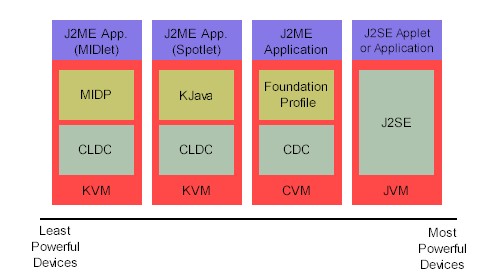J2ME uses configurations and profiles to customize the Java Runtime Environment (JRE). As a complete JRE, J2ME is comprised of a configuration, which determines the JVM used, and a profile, which defines the application by adding domain-specific classes.
The configuration defines the basic run-time environment as a set of core classes and a specific JVM that run on specific types of devices. We'll discuss configurations in detail in the section on J2ME configurations.
The profile defines the application; specifically, it adds domain-specific classes to the J2ME configuration to define certain uses for devices. We'll cover profiles in depth in the section on J2ME profiles.
The following graphic depicts the relationship between the different virtual machines, configurations, and profiles. It also draws a parallel with the J2SE API and its Java virtual machine. While the J2SE virtual machine is generally referred to as a JVM, the J2ME virtual machines, KVM and CVM, are subsets of JVM. Both KVM and CVM can be thought of as a kind of Java virtual machine -- it's just that they are shrunken versions of the J2SE JVM and are specific to J2ME.



